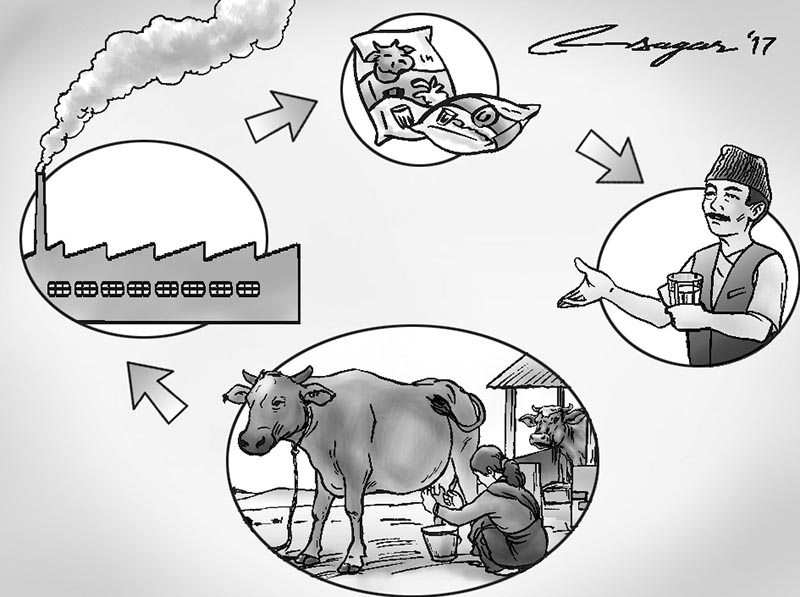
Illustration: Ratna Sagar Shrestha/THT
Food safety is, inevitably, a vital component of food security. However, the compliance with food safety measures (FSM) along the value chain remains elusive in most of the developing countries. The emergence of new modern market chains and increasing integration with the global economy has been putting pressure on the governments for better compliance with FSM along the food value chain. In fact, governments in these countries are now seriously looking for ways and means to improve the status of food safety in these countries.
The status of compliance with FSM in South Asia, in general, is not satisfactory and particularly in Nepal it is precarious and even worse. Nepal often has to incur heavy losses when consignments for exports are rejected due to lack of compliance with FSM. It appeared that the efforts taken by the governments in the past have been largely inadequate. The government’s control and command approach to ensure food safety has not worked satisfactorily due to lack of physical, human and institutional capital for monitoring the compliance with FSM across the entire value chain. Globally, the demand-pull systems have worked well in improving the quality and food safety attributes of the product. Nepal too needs a paradigm shift from relying solely on supply-side food safety and develop demand-pull systems for it.
To understand the status of adoption of FSM and its implications, International Food Policy Research Institute (IFPRI), undertook a comprehensive study on compliance with FSM in Nepal’s milk production. We chose milk as it is one of the most important food item — for rich and poor, young (most importantly children) and old. It is also found to be highly sensitive and carries vector of all possible microbes and extraneous particles in it. We focussed our attention at farm level, as better compliance at production level goes a long way to minimise the chances of contamination at successive levels. The issues such as animal welfare, prevalence of drug residues and antibiotics resistance can be effectively addressed at the farm level.
We investigated the status, estimated the cost, identified the drivers and assessed the impact of compliance with FSM in milk production in Nepal. The study was comprehensive and data were collected from geographically and institutionally diverse regions of Nepal. Our results show that the status of farm level compliance is not very encouraging. On an average only 64% of the recommended measures are adopted by the dairy farmers, though the Government of Nepal released the “code of practices for dairy industry” way back in 2002, in which good dairy practices were developed for safety. The intensity of adoption of FSM exhibits significant variations. The dominance of informal channels in Nepal’s milk market further complicates the compliance and consumers, processors and cooperatives often complain about unhygienic milk production at the farm level.
In comparison to the international standards, Nepal’s mean total bacterial count (TBC) was seen to be nine times higher on farm and 104 times higher in plant, directing an urgent need of improving quality of milk production. It seems farmers are not very enthusiastic to fully comply with FSM since it involves incremental costs and the markets in Nepal often do not reward for food safety. On an average, a dairy farmer in Nepal has to incur an additional expenditure of Rs 2 per litre of milk production. The moot question remains to be answered whether the consumers are willing to compensate the producers for enhanced cost of food safety? Several studies elsewhere in the world illustrate that consumers are willing to pay a premium for safer food products.
Several policy actions are recommended based on comprehensive empirical analysis undertaken by IFPRI. Massive awareness needs to be created among the producers especially related to animal health and hygienic maintenance of the surrounding environment. Farmers should especially be sensitized to discard milk from seriously diseased and infected animals, or even from animals receiving medication.
Periodic monitoring and inspection is critical to ensure adherence to “dairy code practices”. The access to information and frequency of inspection for conformity with safety and quality standards are playing critical role in enhancing the compliance with FSM in Nepal. Farms having information about FSM have shown an 11 percent higher adoption. Similarly, the farms which have been inspected for conformity with safety and quality standards have increased their adoption of FSM by 11 percent.
These findings suggest strengthening of extension delivery and monitoring mechanisms in the country. The government should invest adequately to build physical, institutional and human infrastructure on priority in order to build a robust system to ensure compliance with FSM along the food value chain. Further, the integration with formal channels enhances the adoption of FSM by 8 percent. We need to promote and expand the inclusive formal milk markets to ensure better compliance with FSM. Finally, a pricing strategy based on the quality of milk production should be vigorously pursued to incentivise the famers for higher adoption of FSM. Government of Nepal should develop and prioritize short, medium and long-term action plans for improving compliance with food safety measures to access the global markets and reaping the benefits of expanding trade opportunities in agro-products.
Anjani Kumar is research fellow with the International Food Policy Research Institute. This article was originally published in The Himalayan Times



